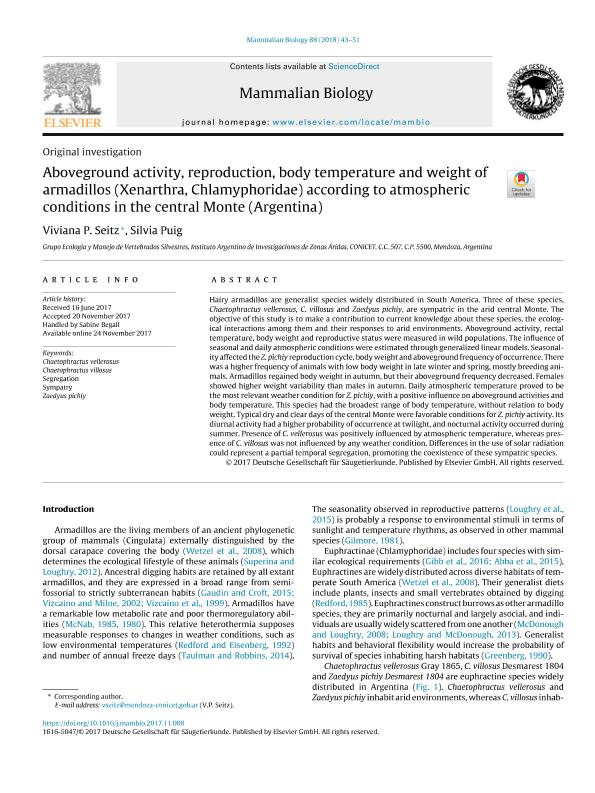Mostrar el registro sencillo del ítem
dc.contributor.author
Seitz, Viviana Paola

dc.contributor.author
Puig, Silvia

dc.date.available
2019-11-05T19:39:58Z
dc.date.issued
2018-01
dc.identifier.citation
Seitz, Viviana Paola; Puig, Silvia; Aboveground activity, reproduction, body temperature and weight of armadillos (Xenarthra, Chlamyphoridae) according to atmospheric conditions in the central Monte (Argentina); Elsevier Gmbh; Mammalian Biology; 88; 1-2018; 43-51
dc.identifier.issn
1616-5047
dc.identifier.uri
http://hdl.handle.net/11336/88079
dc.description.abstract
Hairy armadillos are generalist species widely distributed in South America. Three of these species, Chaetophractus vellerosus, C. villosus and Zaedyus pichiy, are sympatric in the arid central Monte. The objective of this study is to make a contribution to current knowledge about these species, the ecological interactions among them and their responses to arid environments. Aboveground activity, rectal temperature, body weight and reproductive status were measured in wild populations. The influence of seasonal and daily atmospheric conditions were estimated through generalized linear models. Seasonality affected the Z. pichiy reproduction cycle, body weight and aboveground frequency of occurrence. There was a higher frequency of animals with low body weight in late winter and spring, mostly breeding animals. Armadillos regained body weight in autumn, but their aboveground frequency decreased. Females showed higher weight variability than males in autumn. Daily atmospheric temperature proved to be the most relevant weather condition for Z. pichiy, with a positive influence on aboveground activities and body temperature. This species had the broadest range of body temperature, without relation to body weight. Typical dry and clear days of the central Monte were favorable conditions for Z. pichiy activity. Its diurnal activity had a higher probability of occurrence at twilight, and nocturnal activity occurred during summer. Presence of C. vellerosus was positively influenced by atmospheric temperature, whereas presence of C. villosus was not influenced by any weather condition. Differences in the use of solar radiation could represent a partial temporal segregation, promoting the coexistence of these sympatric species.
dc.format
application/pdf
dc.language.iso
eng
dc.publisher
Elsevier Gmbh

dc.rights
info:eu-repo/semantics/openAccess
dc.rights.uri
https://creativecommons.org/licenses/by-nc-nd/2.5/ar/
dc.subject
CHAETOPHRACTUS VELLEROSUS
dc.subject
CHAETOPHRACTUS VILLOSUS
dc.subject
SEGREGATION
dc.subject
SYMPATRY
dc.subject
ZAEDYUS PICHIY
dc.subject.classification
Ecología

dc.subject.classification
Ciencias Biológicas

dc.subject.classification
CIENCIAS NATURALES Y EXACTAS

dc.title
Aboveground activity, reproduction, body temperature and weight of armadillos (Xenarthra, Chlamyphoridae) according to atmospheric conditions in the central Monte (Argentina)
dc.type
info:eu-repo/semantics/article
dc.type
info:ar-repo/semantics/artículo
dc.type
info:eu-repo/semantics/publishedVersion
dc.date.updated
2019-10-16T20:45:33Z
dc.journal.volume
88
dc.journal.pagination
43-51
dc.journal.pais
Alemania

dc.description.fil
Fil: Seitz, Viviana Paola. Consejo Nacional de Investigaciones Científicas y Técnicas. Centro Científico Tecnológico Conicet - Mendoza. Instituto Argentino de Investigaciones de las Zonas Áridas. Provincia de Mendoza. Instituto Argentino de Investigaciones de las Zonas Áridas. Universidad Nacional de Cuyo. Instituto Argentino de Investigaciones de las Zonas Áridas; Argentina
dc.description.fil
Fil: Puig, Silvia. Consejo Nacional de Investigaciones Científicas y Técnicas. Centro Científico Tecnológico Conicet - Mendoza. Instituto Argentino de Investigaciones de las Zonas Áridas. Provincia de Mendoza. Instituto Argentino de Investigaciones de las Zonas Áridas. Universidad Nacional de Cuyo. Instituto Argentino de Investigaciones de las Zonas Áridas; Argentina
dc.journal.title
Mammalian Biology

dc.relation.alternativeid
info:eu-repo/semantics/altIdentifier/doi/https://doi.org/10.1016/j.mambio.2017.11.008
dc.relation.alternativeid
info:eu-repo/semantics/altIdentifier/url/https://www.sciencedirect.com/science/article/pii/S1616504717302197
Archivos asociados
